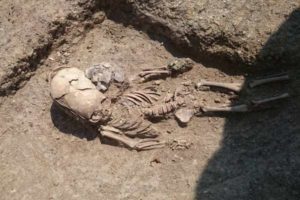
In Crimea, a child's grave with a significantly elongated skull was discovered
 20. 02. 2019
20. 02. 2019

Archaeologists discovered a children's grave during excavations in the Kyz-Aul necropolis, near Kerch, in July 2017, where there was a boy with a significantly elongated skull. The tomb is by scientists dated to the 2nd century AD
According to the scientists, the child's skull was artificially deformed and the boy apparently died in a year and a half because he did not yet have fused cranial seams. Which would prove that they began to deform the skull at a very young age.
Tombs with an elongated skull were discovered earlier
Similarly deformed skulls had appeared in the Crimea before and belonged to the late Sarmatians (translation notes: 2nd-4th century AD). Historians believe that ancient nomads deformed the heads of their children to make it clear of social status or belonging to a particular group.
The discovered remains of a boy with an elongated skull lay in a hollowed-out grave without a tombstone. Along with them, a decorated pottery, small beads and a copper bracelet on his right hand were placed in the grave. The child was buried with his head facing east.
The first finds of elongated skulls in Crimea were made by the founder of Bosphorus archeology, Paul de Brux, in 1826 in the necropolises around the Kerch Strait - in ancient times known as the Bosphorus Kimmer.
The Sarmates believed that the protruding skull was a sign of disorder and therefore deformed the boys to be a dignified warrior of the Bosphorus Empire.
Advocates of palecontact states, however, claim that elongated skulls are another irrefutable proof of alien earth visits. Ufologists are convinced that graves where elbows have been discovered are in fact extraterrestrial and not human.





 6
6
